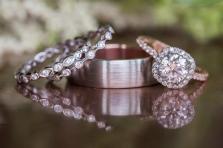| 212-751-3940 | Contact us |
| 5th Ave Showroom | Recently Viewed |
Showroom Hours: M-F by appointment
WE SHIP WORLDWIDE
 |
||
Women's Rings
Men's Rings
Engagement Rings

"We received the ring on Friday - it fits perfectly!!! It's just what John wanted ... and I love the inscription. Thanks so much for making this so easy for us!!!" -Jennifer B., Conn.

Lacy and Stephen are tickled pink over their rings!!
MORE REVIEWS
FOR QUESTIONS OR TO ORDER
CALL 212-751-3940
LIVE HELP ONLINE NOW
We Use Ethically Sourced Precious Metals & Conflict-Free Diamonds
PLEASE FOLLOW US ON:
 |
 |
 |
 |
 |
 Mokume Gane Rings
Mokume Gane Rings
A Brief History of Mokume Gane
Sword smiths in Japan from the late 1600s to mid 1800s developed a wide array of techniques to decorate swords. The samurai sword transitioned from being a tool for fighting battles to a symbol of the warrior class. The quality and amount of decoration on the sword handle became an indicator of one’s social status and wealth. One of the most popular techniques used during this time was called Mokume Gane which translates to wood grain and metal.Denbei Shoami, a 17th century master metal smith is known for creating the method of Mokume Gane, specifically for the adornment of samurai swords. Shoami would create laminated metal billets that were fused by heat and pressure which was then used to fabricate parts of the sword handle. The billets were comprised of many metal variations and finished to produce beautiful patterns within the metal, giving each sword a unique and intricate design. Traditionally practiced, this was a very difficult process to learn due to the skill required to forge the laminated billet down to usable material, without separating the layers.
The Modern Story of Mokume Gane
The husband and wife team of Eugene Michael Pijanowski and Hiroko Sato Pijanowski brought Mokume Gane to the United States in the early 1970s. They learned the technique from ninth generation metalsmith Norio Tamagawa in Japan. Today, Mokume Gane rings are created by layering precious and semi-precious metals such as Gold, Platinum, Palladium, Sterling Silver and Copper. The layers are bonded and formed by rolling, forging, and twisting. A combination of techniques including punches, chiseling, carving, and surface abrasion exposes the beauty of the work: the unique layering of these metals. A Mokume Gane artisan can make an unlimited number of distinct patterns with no two being precisely the same, which is one of the reasons why this style is commonly used for wedding rings.Mokume Gane Rings - Care Instructions
The highest contrast between the adjacent Gold, Silver, Platinum, or Palladium alloys in your Mokume Gane ring is obtained with a matte surface finish. In all likelihood, the Mokume Gane ring you plan to purchase, even one that is etched, has a matte surface finish. Over time, the matte surface finish can and will change character.Homemade Methods to Clean Mokume Gane Rin
Maintaining the surface finish can be done at home with a jewelry cleaner. Another at home cleaning solution can be as simple as using products in your cabinets. Saturate a fine scour pad with liquid soap and gently stroke the ring along its circumference under a slow stream of running water. Keep the pad saturated with soap so that you are constantly providing lubricant while cleansing the ring. A fine scour pad can be found at your local hardware or grocery store. Another cleaning option is to place whitening toothpaste on the scour pad, and proceed as described above. You will obtain a matte surface finish with a slightly higher luster.For the inside finish of the ring, you can use the scour pad method, as described above, to achieve a matte surface finish as well. If you prefer a semi-polished finish, use the polishing cloth. Through proper care and preventative actions, you can maintain the look and feel of your Mokume Gane ring.
Mokume Gane rings - Shakudo Gold
Shakudo is a Japanese alloy made of 96% copper and 4% fine gold. A Shakudo wedding ring has a natural copper aura that when processed with patina treatment turns black. After being treated, the Shakudo does change color due to a reaction with chemicals in the environment or an individual's body chemistry. It will naturally re-darken over time through contact with water, air, the skin, and chemicals such as ammonia. Depending on skin acidity levels and other enviornmental factors the color can continually be variable.How do you choose a Mokume Gane ring?
When thinking about buying your Mokume Gane ring, something to keep in mind is that you will have a wedding or engagement ring that stands out from the crowd. Due to the way this jewelry is created, they are one of a kind. Many couples feel this uniqueness makes them the ideal symbol of their relationship. Mokume gane rings come in a wide range of patterns and metal combinations. Learn about all the options before you choose your wedding band or engagement jewelry. Working with a designer at Wedding Rings Originals can help you select the perfect ring.
Visit us by appointment at:
608 Fifth Avenue (corner 49 Street) Suite 509, New York, NY 10020 212-751-3940
608 Fifth Avenue (corner 49 Street) Suite 509, New York, NY 10020 212-751-3940
Thank you!
Visit us by appointment at:
608 Fifth Avenue Suite 509
(corner 49 Street)
New York, NY 10020
212-751-3940
Thank you!
608 Fifth Avenue Suite 509
(corner 49 Street)
New York, NY 10020
212-751-3940
Thank you!
Copyright 1999-2024 Wedding Ring Originals
Copyright 1999-2024 Wedding Ring Originals
Copyright 1999-2024 Wedding Ring Originals



